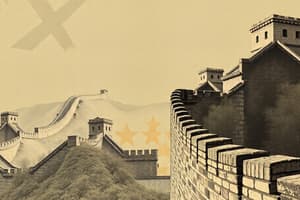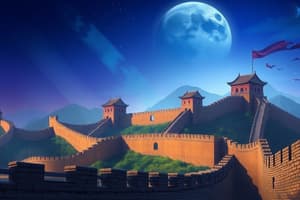Podcast
Questions and Answers
The Great Wall influenced the development of traditional Chinese culture, including attire, ______, and architecture
The Great Wall influenced the development of traditional Chinese culture, including attire, ______, and architecture
food
The Great Wall of China has been considered a symbol of ______ and power
The Great Wall of China has been considered a symbol of ______ and power
strength
UNESCO added the Great Wall to their list of World Heritage Sites in ______
UNESCO added the Great Wall to their list of World Heritage Sites in ______
1987
Despite claims, the Great Wall is not visible from ______
Despite claims, the Great Wall is not visible from ______
Some sections of the Great Wall were built by the ______ themselves
Some sections of the Great Wall were built by the ______ themselves
A section of the Great Wall is hidden beneath the streets of ______
A section of the Great Wall is hidden beneath the streets of ______
Originally constructed between the 7th century BC and the 7th century AD, the Great Wall of China was built primarily by soldiers, peasants, and some ______.
Originally constructed between the 7th century BC and the 7th century AD, the Great Wall of China was built primarily by soldiers, peasants, and some ______.
The Great Wall of China acted as a defensive line against invasions from nomadic tribes to the ______.
The Great Wall of China acted as a defensive line against invasions from nomadic tribes to the ______.
Despite popular belief, the Great Wall was never continuously ______; instead, troops were stationed along it only when necessary.
Despite popular belief, the Great Wall was never continuously ______; instead, troops were stationed along it only when necessary.
During the Ming Dynasty, the Great Wall was transformed into an impenetrable fortress with watchtowers and garrison ______.
During the Ming Dynasty, the Great Wall was transformed into an impenetrable fortress with watchtowers and garrison ______.
The construction process of the Great Wall involved stacking bricks or stones one upon another to create a solid ______.
The construction process of the Great Wall involved stacking bricks or stones one upon another to create a solid ______.
The Great Wall represents unity among different ethnic groups under the rule of imperial ______.
The Great Wall represents unity among different ethnic groups under the rule of imperial ______.
Flashcards are hidden until you start studying
Study Notes
The Great Wall of China: A Symbol of History and Engineering Marvel
The Great Wall of China is one of the most iconic landmarks globally, stretching over 13,000 miles across northern China. Originally constructed between the 7th century BC and the 7th century AD, it was built primarily by soldiers, peasants, and some prisoners. While much of what we know about the construction comes from various myths and legends, there's evidence it did play a significant role in Chinese history. In this article, we will explore the purpose, significance, and lesser-known facts about the Great Wall of China.
Purpose and Construction
Initially, the wall acted as a defensive line against invasions from nomadic tribes to the north. Later, during the Ming Dynasty, the wall was transformed into an impenetrable fortress with watchtowers and garrison stations. Despite popular belief, it was never continuously manned; instead, troops were stationed along it only when necessary.
The construction process involved stacking bricks or stones one upon another to create a solid base. Around this core, workers added layers of rammed earth and rubble, creating walls up to 5 meters high and 8 meters wide. To prevent further erosion, they plastered each layer with clay mixed with straw or sand.
Significance
The Great Wall has profound symbolism beyond its historical significance. It represents unity among different ethnic groups under the rule of imperial China. For many centuries, the Great Wall has been considered a symbol of strength and power, inspiring generations of Chinese people. It also influenced the development of traditional Chinese culture, including attire, food, and architecture.
Moreover, the Great Wall has become a global cultural icon. As UNESCO wrote while adding it to their list of World Heritage Sites in 1987, "it is a monument not only to the military genius of successive dynasties...but also to the wisdom of different cultures which through the years have contributed to the grandeur of this architectural construction."
Lesser-Known Facts
Despite being one of the best-known structures in human history, there are still many mysteries surrounding the Great Wall:
- The Great Wall is not visible from space, despite numerous claims suggesting otherwise.
- Some sections of the wall were actually built by the Mongols themselves, who would later help destroy parts of it.
- A section of the Great Wall is currently hidden beneath the streets of Beijing, making access impossible without excavations.
- The quality of construction varies greatly along its length because construction methods changed over time.
In conclusion, the Great Wall of China stands as an enduring testament to ancient engineering prowess and national unity. Its influence extends far beyond borders, shaping global perceptions about Chinese civilization. Although much remains unknown about its origins and construction, its significance remains undeniable.
Studying That Suits You
Use AI to generate personalized quizzes and flashcards to suit your learning preferences.





